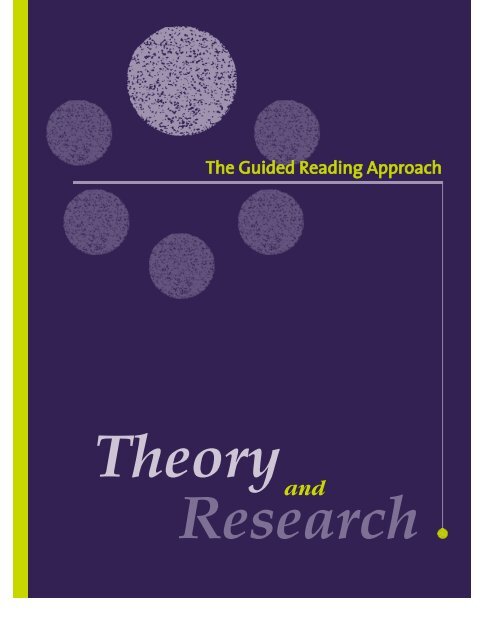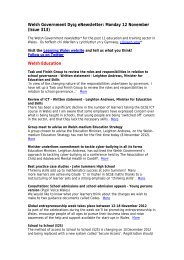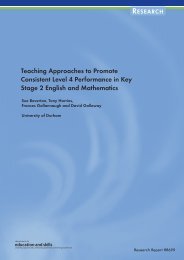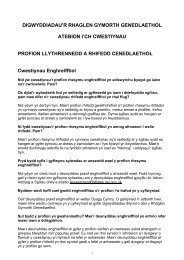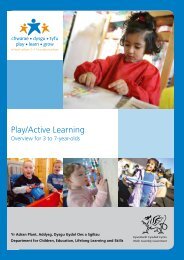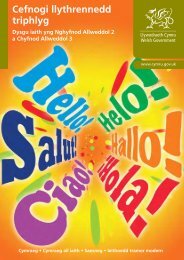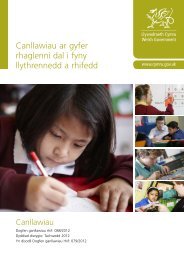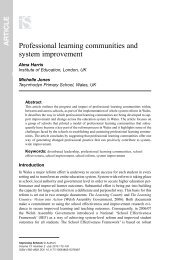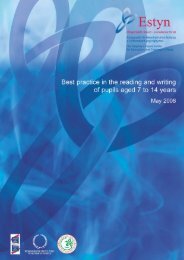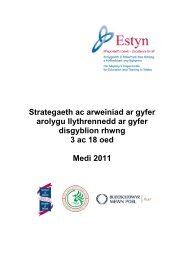The Guided Reading Approach â Theory and ... - Learning Wales
The Guided Reading Approach â Theory and ... - Learning Wales
The Guided Reading Approach â Theory and ... - Learning Wales
You also want an ePaper? Increase the reach of your titles
YUMPU automatically turns print PDFs into web optimized ePapers that Google loves.
<strong>The</strong> <strong>Guided</strong> <strong>Reading</strong> <strong>Approach</strong><br />
<br />
<br />
<strong>and</strong>
Distributed in the United States of America by Pacific <strong>Learning</strong>,<br />
P.O. Box 2723, Huntington Beach, CA 92647-0723<br />
www.pacificlearning.com<br />
Published 2002 by <strong>Learning</strong> Media Limited,<br />
Box 3293, Wellington 6001, New Zeal<strong>and</strong><br />
www.learningmedia.com<br />
Copyright © <strong>Learning</strong> Media Limited 2002<br />
All rights reserved. Inquiries should be made to the publisher.<br />
Printed in New Zeal<strong>and</strong><br />
ISBN 0 478 26475 5<br />
PL-9819
<strong>Guided</strong> <strong>Reading</strong>: Grounded in<br />
<strong>The</strong>oretical Underst<strong>and</strong>ings<br />
Jeanne Biddulph<br />
How this aligns with the<br />
guided reading process<br />
1. <strong>Guided</strong> reading enables<br />
teachers to provide very<br />
effective support for students’<br />
literacy learning.<br />
2. <strong>The</strong> teacher’s role in guided<br />
reading is to actively enhance<br />
students’ underst<strong>and</strong>ing.<br />
Introduction<br />
<strong>Guided</strong> reading is an important approach in literacy education. Used in<br />
conjunction with other approaches (such as shared reading, reading aloud,<br />
<strong>and</strong> independent reading), it enables teachers to provide very effective<br />
support for students’ literacy learning.<br />
How does guided reading provide such support What is involved in using<br />
a guided reading approach A teacher using a guided reading approach<br />
• selects a text that is appropriate for a particular group of students<br />
(usually of similar reading ability),<br />
• introduces that text by talking to the students about relevant experiences<br />
that they may have had,<br />
• provides sensitive support for the students to “talk, read, <strong>and</strong> think their<br />
way purposefully through” the text (<strong>Reading</strong> for Life, 1997, p. 80).<br />
<strong>The</strong> reading is done silently (or “quietly, to yourself” if the student is an<br />
emergent reader). Discussion of the text before, after, <strong>and</strong> sometimes during<br />
the reading is central to the approach because the fundamental purpose is to<br />
enhance each student’s underst<strong>and</strong>ing of what they are reading.<br />
<strong>The</strong> teacher’s role in guided reading is to scaffold literacy learning, that is,<br />
to actively enhance students’ underst<strong>and</strong>ing. This is in marked contrast to the<br />
practice of merely checking or testing comprehension after a text has been<br />
read by the student. <strong>The</strong> distinction is critical because, as Dowhower (1999)<br />
reports, there is evidence that many teachers unwittingly assume the role of<br />
interrogators because they tend to confuse assessment with direct teaching<br />
of comprehension. <strong>Guided</strong> reading is an approach to literacy education that<br />
can help overcome that confusion. It can help teachers refocus on the vitally<br />
important teaching role.<br />
For guided reading to be used effectively, however, teachers need to be<br />
aware of <strong>and</strong> appreciate the basic underst<strong>and</strong>ings or underlying theoretical<br />
perspectives on which the approach is based. Sometimes the view is<br />
expressed that teachers do not need to concern themselves with theory, but<br />
this is not so. Whether teachers (or curriculum developers or curriculum<br />
writers) recognize it or not, all their work has a theoretical basis. From a<br />
professional point of view, it is important to identify <strong>and</strong> acknowledge the<br />
theoretical perspectives (underst<strong>and</strong>ings) that underpin such work. This<br />
paper endeavors to do this with respect to guided reading.<br />
2 <strong>The</strong> <strong>Guided</strong> <strong>Reading</strong> <strong>Approach</strong>
Basic Underst<strong>and</strong>ings That Underpin a <strong>Guided</strong><br />
<strong>Reading</strong> <strong>Approach</strong><br />
<strong>The</strong> theories that underpin guided reading are complex <strong>and</strong> varied, <strong>and</strong><br />
a full discussion of these is well beyond the scope of this paper. Braunger<br />
<strong>and</strong> Lewis (1998, p. 5), for example, have identified thirteen “core<br />
underst<strong>and</strong>ings about learning to read,” all of which have a basis in<br />
research <strong>and</strong> theory <strong>and</strong> are significant for classroom literacy programs<br />
in general <strong>and</strong> relevant to a consideration of guided reading in particular.<br />
This paper considers the six basic underst<strong>and</strong>ings that are most directly<br />
relevant <strong>and</strong> meaningful to a classroom teacher using guided reading at<br />
grades 3–5.<br />
3. Readers build their own<br />
underst<strong>and</strong>ings of the author’s<br />
message.<br />
1. <strong>Reading</strong> is a construction of meaning from written text – it is<br />
an active, cognitive, <strong>and</strong> affective process<br />
<strong>Reading</strong> is an interactive process in which readers actively engage with<br />
texts, building their own underst<strong>and</strong>ing of the author’s message. <strong>The</strong><br />
meaning they make is at the heart of the reading process (Braunger <strong>and</strong><br />
Lewis, 1998; Clay, 1991, 1998; <strong>Learning</strong> Media, 1997; Pressley, 1998).<br />
However, as Pressley points out, although the development of comprehension<br />
is a widely agreed-upon goal of literacy instruction, it “rarely is offered as<br />
systematically as it could be in the elementary grades” (1998, p. 222).<br />
Dowhower (1999) also expresses concern that discussions of text content<br />
<strong>and</strong> teaching of strategies to enhance comprehension have been rare in<br />
classrooms. Such strategies, Dowhower suggests, should include:<br />
(i) activating background knowledge,<br />
(ii) predicting,<br />
(iii) generating visual images,<br />
(iv) summarizing,<br />
(v) self-questioning,<br />
(vi) analyzing text for story grammar (or story structure) elements (including<br />
narrative story parts, such as character or events, as well as the ways<br />
that content-area texts are organized),<br />
(vii) making inferences,<br />
(viii) distinguishing important information,<br />
(ix) synthesizing,<br />
(x) monitoring, <strong>and</strong><br />
(xi) learning to repair faulty comprehension.<br />
This might seem to be a daunting list, but each is an important strategy <strong>and</strong>,<br />
as Fielding <strong>and</strong> Pearson (1994, p. 67, cited in Dowhower, 1999) point out,<br />
students are more likely to make these comprehension strategies their own<br />
when they have frequent <strong>and</strong> systematic opportunities to read <strong>and</strong> discuss<br />
whole text with a teacher <strong>and</strong> peers.<br />
<strong>The</strong> challenge for teachers is to provide these opportunities frequently,<br />
thereby facilitating the development of effective strategies for comprehending<br />
both narrative <strong>and</strong> expository texts of many kinds (Braunger <strong>and</strong> Lewis,<br />
1998; Caswell <strong>and</strong> Duke, 1998; Flippo, 1998). <strong>Guided</strong> reading is an<br />
approach that is concerned with the development of comprehension.<br />
3 <strong>The</strong> <strong>Guided</strong> <strong>Reading</strong> <strong>Approach</strong>
4. <strong>Guided</strong> reading is an<br />
approach that is concerned<br />
with the development of<br />
comprehension.<br />
5. Ongoing analysis of individual<br />
students’ strengths <strong>and</strong> needs<br />
is important.<br />
6. Students are more likely to<br />
make meaningful connections<br />
with new information if they<br />
already know something<br />
about it.<br />
7. When using guided reading,<br />
teachers need to consider the<br />
extent to which their students’<br />
existing knowledge matches<br />
the ideas in the text.<br />
8. <strong>Guided</strong> reading enables<br />
teachers to become aware<br />
of <strong>and</strong> cater effectively for<br />
the diversity of underst<strong>and</strong>ing<br />
that students bring to their<br />
readings.<br />
It is specifically designed to enable comprehension strategies to be taught<br />
systematically <strong>and</strong> used by students across a range of texts. <strong>The</strong> emphasis is<br />
on silent reading because it is more authentic <strong>and</strong> relevant to real life than<br />
oral reading, <strong>and</strong> it is also more effective for learning than oral reading,<br />
especially “oral round-robin” reading, which has been shown to decrease<br />
comprehension (Dowhower, 1999).<br />
Because teachers work closely with relatively small groups for guided<br />
reading, they are able to monitor carefully each student’s processing of texts<br />
<strong>and</strong> adjust further teaching <strong>and</strong> text selection in the light of their responses.<br />
<strong>The</strong> importance of this ongoing analysis of individual students’ strengths <strong>and</strong><br />
needs is emphasized by various writers (see, for example, Flood, Lapp,<br />
Flood, <strong>and</strong> Nagel, 1992).<br />
2. Background knowledge <strong>and</strong> prior experience are critical to<br />
the reading process<br />
<strong>The</strong> crucial role of prior knowledge in reading is widely recognized<br />
(Anderson <strong>and</strong> Pearson, 1984, cited in Braunger <strong>and</strong> Lewis, 1998, p. 28;<br />
Caswell <strong>and</strong> Duke, 1998) <strong>and</strong> is often discussed in terms of “schema<br />
theory.” Schema theory attempts to explain how meaning-making occurs<br />
<strong>and</strong> how knowledge is stored <strong>and</strong> organized in the brain. According to<br />
Henk (1993), schemata represent the knowledge structures in readers’<br />
minds, <strong>and</strong> these structures allow readers to connect new information with<br />
what they already know. In his view, “incoming” information either fits into<br />
existing knowledge structures or forces the emergence of new ones. When<br />
readers encounter new examples of things for which they have an existing<br />
schema, they are more likely to make meaningful connections with that new<br />
information than they are if relevant schemata are lacking. Pressley (1998)<br />
also discusses the concept of schema activation, noting that activation can<br />
“dramatically affect” (p. 201) comprehension, attention allocation, <strong>and</strong><br />
memory of what is read.<br />
When planning <strong>and</strong> implementing guided reading sessions, teachers are<br />
encouraged to consider the extent to which their students’ existing schemata<br />
match the ideas embedded in the text. Readers must draw from their<br />
existing knowledge in order to underst<strong>and</strong> text (Braunger <strong>and</strong> Lewis, 1998),<br />
<strong>and</strong> the meanings they construct will vary somewhat from reader to reader<br />
(Pressley, 1998). Multiple interpretations are generated amongst readers<br />
because their responses to literature are both personal <strong>and</strong> grounded in text<br />
(Spiegel, 1998).<br />
It is therefore important that teachers develop an awareness of the range<br />
of background knowledge that students bring to school, including their<br />
“overall” prior knowledge <strong>and</strong> the specific prior knowledge required to<br />
read particular texts (Braunger <strong>and</strong> Lewis, 1998). <strong>Guided</strong> reading enables<br />
teachers both to develop this awareness <strong>and</strong> to cater effectively for the<br />
diversity that is usually revealed. For example, where there seems to be a<br />
close match between the schema of the student <strong>and</strong> that embedded in the<br />
text, teachers can consciously “activate” students’ relevant schema during<br />
the introduction to guided reading <strong>and</strong> extend that knowledge during the<br />
reading <strong>and</strong> the discussion that follows. However, when students’ existing<br />
schemata for a text appear to be limited, judgments need to be made about<br />
4 <strong>The</strong> <strong>Guided</strong> <strong>Reading</strong> <strong>Approach</strong>
whether that particular text should be used for guided reading with those<br />
students or whether an alternative text that is more relevant to their<br />
background knowledge should be sought. In situations where students are<br />
required to read texts for which they have limited schemata, special<br />
teaching strategies are required to develop the background knowledge that<br />
the students bring to the text. Teachers may, for example, provide<br />
introductory activities (such as discussions of photographs, video clips, or<br />
maps) to enhance the students’ background knowledge before they read<br />
<strong>and</strong> as they guide the group through the text. Alternatively, teachers may<br />
decide to read the text aloud to the students if they think that more teacher<br />
support is required to make the text accessible to the group.<br />
3. Social interaction is essential when learning to read<br />
Interaction with others (both adults <strong>and</strong> peers) in a wide variety of settings is<br />
an essential part of students’ language <strong>and</strong> literacy learning (Braunger <strong>and</strong><br />
Lewis, 1998; Spiegel, 1998; Wiencek <strong>and</strong> O’Flahavan, 1994). In fact,<br />
classroom studies show that the amount <strong>and</strong> breadth of students’ reading is<br />
strongly related to social interaction as well as strategy teaching (Guthrie,<br />
Schafer, Wang, <strong>and</strong> Afflerbach, 1995).<br />
In Vygotsky’s (1978) view, learning is a “social occurrence” that can be<br />
fostered when teaching is focused in the learner’s “zone of proximal<br />
development.” This zone has been described as the area between the level<br />
at which the student is currently achieving <strong>and</strong> the level at which the student<br />
can achieve if there is assistance from a more knowledgeable person or, in<br />
Braunger <strong>and</strong> Lewis’s terms (1998, p. 29), a “more sophisticated other.”<br />
9. Literacy develops best through<br />
social interaction <strong>and</strong> dialogue<br />
with others.<br />
10. <strong>Guided</strong> reading is essentially<br />
a carefully managed “social<br />
occurrence.”<br />
Because literacy develops best through social interaction <strong>and</strong> dialogue with<br />
others (Dowhower, 1999), teachers are advised to “scaffold” or support<br />
students’ learning by collaborative means to help them make sense of<br />
literature <strong>and</strong> become actively engaged in meaning-making more generally<br />
(Dugan, 1997). This is a “social constructivist” view of teaching. It involves<br />
the teacher making a shift from asking predetermined questions designed to<br />
ensure that the students arrive at the “right” meaning to facilitating<br />
conversations that encourage students’ exploratory talk as they arrive at a<br />
deeper meaning (Gavelek <strong>and</strong> Raphael, 1996).<br />
<strong>The</strong>se underst<strong>and</strong>ings about literacy learning are highly relevant to guided<br />
reading because guided reading is essentially a carefully managed “social<br />
occurrence.” During guided reading, the teacher works to extend the<br />
students’ literacy development by responding sensitively to their efforts <strong>and</strong><br />
providing appropriate, ongoing guidance <strong>and</strong> support as they read (Fountas<br />
<strong>and</strong> Pinnell, 1996). Within these learning experiences, teachers are<br />
developing not only students’ ability to underst<strong>and</strong> more fully the particular<br />
texts being read but also their ability to use a range of reading <strong>and</strong> thinking<br />
(metacognitive) strategies when processing other texts they encounter.<br />
Further underst<strong>and</strong>ings about the social interaction involved in learning to<br />
read <strong>and</strong> the need for the “more sophisticated other” to respond sensitively<br />
to the learner are detailed by McNaughton (1995). Drawing on his<br />
research with New Zeal<strong>and</strong> families <strong>and</strong> the ideas of writers such as<br />
Vygotsky, Heath, <strong>and</strong> Bronfenbrenner, he discusses students’ early literacy<br />
5 <strong>The</strong> <strong>Guided</strong> <strong>Reading</strong> <strong>Approach</strong>
learning in terms of a theory of “co-construction.” He stresses the<br />
significance of constant interaction between a student’s own mental<br />
constructions <strong>and</strong> those of his/her family <strong>and</strong> cultural group. He argues that<br />
these constructions are a joint outcome of personal <strong>and</strong> social activities,<br />
which vary considerably from family to family or one community to another.<br />
<strong>The</strong> effect is that students develop particular kinds of expertise, for example,<br />
some become expert at memorising, some at reading aloud as a<br />
“performance,” <strong>and</strong> others become skilled at asking questions. According to<br />
McNaughton, the students’ concepts are continually constructed <strong>and</strong><br />
changed as a result of their own personal behavior <strong>and</strong> that of others,<br />
hence the notion of co-construction.<br />
<strong>The</strong> implications of social constructivist underst<strong>and</strong>ings for teachers at all<br />
levels of the school are significant, especially for those supporting the<br />
literacy development of students whose language/cultural backgrounds<br />
differ from their own. To implement guided reading effectively, teachers<br />
need to be fully aware of the nature <strong>and</strong> impact of the diversity among their<br />
students <strong>and</strong> seek strategies for catering for this diversity. For example,<br />
extra care is needed to ensure that the texts selected for guided reading <strong>and</strong><br />
the processes employed throughout the approach connect with <strong>and</strong> build on<br />
the students’ existing expertise. When discussing texts, teachers should be<br />
aware that students from diverse backgrounds may not necessarily respond<br />
to questions in ways that teachers expect, not because they “have limited<br />
language” or “lack concentration,” but because their experiences to date<br />
have not yet enabled them to develop the particular forms of expertise <strong>and</strong><br />
ways of responding that teachers tend to expect. It is widely acknowledged<br />
that teachers’ expectations can result in judgments about students’<br />
educational potential on the basis of how they behave <strong>and</strong> talk, thereby<br />
setting up self-fulfilling prophecies that lead to the anticipated differences in<br />
levels of achievement. Wood (1988) says “Crudely, because some teachers<br />
expect less of students from some social backgrounds, these students are<br />
taught <strong>and</strong> learn less.” Gaining adequate awareness of diversity <strong>and</strong> then<br />
responding appropriately to that diversity is not an easy task for teachers.<br />
Cazden (1988 <strong>and</strong> 1992) <strong>and</strong> Lindfors (1987) explore in detail the<br />
difficulties that arise for students when the language competencies <strong>and</strong><br />
expectations they bring to classrooms are not adequately recognized,<br />
understood, or catered for by their teachers.<br />
11. <strong>Guided</strong> reading helps students<br />
to underst<strong>and</strong> particular texts<br />
<strong>and</strong> to use a range of reading<br />
<strong>and</strong> thinking strategies on<br />
other texts.<br />
<strong>Guided</strong> reading is an approach that provides many opportunities both to<br />
support students’ language/literacy development sensitively <strong>and</strong> carefully<br />
<strong>and</strong> to develop greater awareness of the particular forms of expertise that<br />
individual students bring to language <strong>and</strong> literacy experiences. Often there<br />
are subtle but significant differences in the ways in which different students<br />
respond during discussion of texts, <strong>and</strong> this is evident to the sensitive<br />
listener/observer, particularly during the discussions that follow the guided<br />
reading of a text. Some may respond confidently to teachers’ questions, but<br />
others may have difficulty when “interrogated” or questioned directly by<br />
teachers. Such students may engage more readily <strong>and</strong> learn more effectively<br />
if the discussion takes the form of a genuine conversation (Wiencek <strong>and</strong><br />
O’Flahavan, 1994), especially one in which their questions are encouraged.<br />
In group instruction where students feel safe <strong>and</strong> secure, they are willing to<br />
take risks, to become more involved, <strong>and</strong> therefore they gain more<br />
experience <strong>and</strong> confidence in exploring <strong>and</strong> articulating their own<br />
6 <strong>The</strong> <strong>Guided</strong> <strong>Reading</strong> <strong>Approach</strong>
interpretations of material. In teacher-student discourse, Tierney (1998,<br />
p. 389) notes the need for spaces where “students <strong>and</strong> teachers connect<br />
or transact with each other, rather than pass by one another. <strong>The</strong> key is<br />
finding ways to involvement <strong>and</strong> transaction rather than detachment <strong>and</strong><br />
monolithic responses.”<br />
12. <strong>Guided</strong> reading enables<br />
authentic, ongoing monitoring<br />
of students’ literacy<br />
development.<br />
13. Assessment that emerges from<br />
the classroom rather than<br />
being imposed upon it is<br />
integral to guided reading.<br />
Ongoing observation <strong>and</strong> monitoring of students’ responses in a range of<br />
learning contexts (including guided <strong>and</strong> independent reading settings) is of<br />
critical importance to both student <strong>and</strong> teacher. In fact, it could be argued<br />
that this form of assessment is one of the most “authentic” <strong>and</strong> valuable of<br />
those available to teachers <strong>and</strong> that guided reading is an approach that<br />
provides frequent opportunities for such authentic monitoring to take place.<br />
Tierney (1998) suggests that teachers are in a better position to know <strong>and</strong><br />
learn about an individual’s development than outsiders because they are<br />
with the student over time <strong>and</strong> they become aware of the “subtle changes<br />
<strong>and</strong> nuances of learning within <strong>and</strong> across learning activities” (p. 377).<br />
Assessment that “emerges from the classroom” rather than being “imposed<br />
upon it” is particularly valuable (Tierney, 1998, p. 375), <strong>and</strong> this is the form<br />
of assessment that is integral to guided reading. When implemented<br />
effectively, a guided reading approach provides an excellent example of<br />
assessment <strong>and</strong> teaching operating as integrated processes, each informing<br />
the other to meet the individual needs of students (Braunger <strong>and</strong> Lewis,<br />
1998, p. 53). It is an approach that also provides opportunities for students<br />
to assess their own learning because they are encouraged, in a supportive<br />
context, to reflect on <strong>and</strong> articulate what <strong>and</strong> how they are learning, thereby<br />
building their abilities in metacognitive functioning.<br />
4. Engagement in the reading task is a key to successfully<br />
learning to read<br />
When students want to read, have authentic purposes for reading texts that<br />
are relevant <strong>and</strong> meaningful to them, <strong>and</strong> are supported in their reading,<br />
their motivation is usually high (Au, 1997; Johnston, 1997; Spiegel, 1998).<br />
Under such conditions, they will engage much more readily <strong>and</strong> successfully<br />
in the reading task <strong>and</strong> associated activities (Cambourne, 1988, 1998;<br />
Flippo, 1998). Cambourne (1998) analyzed the “teaching-learning<br />
activities” that, in his view, lie “at the heart of literacy teaching.” He<br />
suggests that “teaching-learning activities ‘worked’ if<br />
(i) they actively engaged the learners,<br />
(ii) learners learned that which the teachers considered to be important, <strong>and</strong><br />
(iii) they promoted collaboration <strong>and</strong> independence in the learners, thus<br />
providing opportunities for teachers to work one-to-one, or with small<br />
groups, as needed.”<br />
<strong>The</strong> nature <strong>and</strong> extent of students’ engagement in literacy learning is critical<br />
because those who enjoy their learning experiences <strong>and</strong> participate fully in<br />
them are likely to become competent, enduring readers <strong>and</strong> writers. One of<br />
the important aims of reading programs therefore is to create in students a<br />
positive attitude towards reading (Smith <strong>and</strong> Elley, 1997), <strong>and</strong> Tierney<br />
(1998) argues that one focus of literacy assessment should be the extent to<br />
which a student’s interest <strong>and</strong> engagement are maintained across a range<br />
of materials for different purposes.<br />
7 <strong>The</strong> <strong>Guided</strong> <strong>Reading</strong> <strong>Approach</strong>
14. <strong>Guided</strong> reading ensures that<br />
the reading experiences of<br />
students are meaningful,<br />
purposeful, <strong>and</strong> nonthreatening.<br />
15. <strong>Guided</strong> reading ensures that<br />
students experience success<br />
<strong>and</strong> enjoyment so that they will<br />
gradually develop greater<br />
independence <strong>and</strong> competence.<br />
16. <strong>Guided</strong> reading requires that<br />
comprehension strategies be<br />
modeled by teachers <strong>and</strong> that<br />
students be encouraged to use<br />
them independently before,<br />
during, <strong>and</strong> after their reading<br />
of a text.<br />
Meeting these conditions is possible in guided reading sessions because<br />
care is taken to ensure that the reading experiences of students are<br />
meaningful, purposeful, <strong>and</strong> non-threatening. Groups are small enough<br />
to allow each student to participate fully, <strong>and</strong> each session provides<br />
opportunities for self-reliance, self-evaluation, <strong>and</strong> interaction with others.<br />
<strong>Guided</strong> reading both challenges <strong>and</strong> supports students. It is designed to<br />
ensure that they experience success <strong>and</strong> enjoyment so that they will continue<br />
to engage as readers, gradually developing greater independence <strong>and</strong><br />
competence. Au (1991), Dugan (1997), <strong>and</strong> others argue that supportive<br />
patterns of interaction are particularly beneficial to literacy learning.<br />
5. Students learn successful reading strategies in the context of<br />
real reading<br />
In order to construct meaning effectively, students need to learn appropriate<br />
strategies for “orchestrating the information provided at all levels of the four<br />
cueing systems” (Braunger <strong>and</strong> Lewis, 1998, p. 44), as outlined in section 6<br />
below. Pressley (1998, p. 220) argues that there is “substantial evidence<br />
that elementary students can learn to comprehend actively – they can learn<br />
to predict, question, make mental images, seek to clarify confusions, <strong>and</strong><br />
summarize as they read,” <strong>and</strong> he emphasizes the importance of teachers<br />
modeling this learning.<br />
Central to guided reading is the underst<strong>and</strong>ing that comprehension<br />
strategies will be modeled by teachers <strong>and</strong> that students will be encouraged<br />
to use them before, during, <strong>and</strong> after they read a text. When they are<br />
engaged in guided reading, they are solving problems as they read for<br />
meaning <strong>and</strong>, over time, they will learn to use various strategies across<br />
a range of texts. As they do so, they are supported by the guidance,<br />
demonstrations, <strong>and</strong> explanations of their teacher (Button, Johnson, <strong>and</strong><br />
Furtyerson, 1996). <strong>The</strong> aim, though, is to encourage students to use these<br />
strategies independently to facilitate their development as readers<br />
(Dowhower, 1999).<br />
In Au’s (1997) view, “authentic” literacy activities (that is, ones that are<br />
real <strong>and</strong> meaningful for the students involved) are central to a successful<br />
classroom literacy program, especially for students of diverse backgrounds.<br />
<strong>The</strong> emphasis in guided reading is on “real” reading of “real” texts (of<br />
whatever variety) because teachers seek material that is relevant <strong>and</strong><br />
meaningful to the students with whom they are working.<br />
17. Written language relies on<br />
four cueing systems.<br />
6. <strong>Reading</strong> involves complex thinking<br />
<strong>Reading</strong> involves using a range of thinking skills in order to make sense<br />
of texts. Although there are many theories about the workings of written<br />
language, Braunger <strong>and</strong> Lewis (1998, p. 30) confirm that “most are in<br />
agreement that written language relies on four cueing systems, representing<br />
types of knowledge the reader uses as he interacts with text:<br />
(a)<br />
(b)<br />
(c)<br />
pragmatic (social context)<br />
semantic (meaning)<br />
syntactic (structural)<br />
8 <strong>The</strong> <strong>Guided</strong> <strong>Reading</strong> <strong>Approach</strong>
(d)<br />
grapho-phonic (the alphabetic, orthographic, sound symbol aspects).<br />
All of these must be operating in t<strong>and</strong>em for optimal meaning.”<br />
Smith <strong>and</strong> Elley (1997, p. 78) also emphasize the way in which various<br />
cues should “interact to help the student achieve a successful underst<strong>and</strong>ing<br />
of the author’s message, <strong>and</strong> by mutual interaction help him/her build up a<br />
repertoire of strategies for doing so efficiently <strong>and</strong> independently in future.”<br />
18. <strong>Guided</strong> reading encourages<br />
students to use all four cueing<br />
systems <strong>and</strong> to cross-check<br />
one source with others.<br />
19. Skill instruction should take<br />
place within the context of<br />
students’ engagement in<br />
meaningful activities.<br />
<strong>Guided</strong> reading provides an ideal setting for teachers to encourage students<br />
to use all four sources of information (cueing systems) as they read <strong>and</strong> to<br />
cross-check one source with others. In the course of regular guided reading<br />
sessions, classroom teachers are able both to develop <strong>and</strong> monitor these<br />
cross-checking behaviors across a range of increasingly complex texts. Au<br />
(1997) argues that such “skill instruction” can <strong>and</strong> should take place within<br />
the context of students’ engagement in meaningful activities, emphasizing that<br />
this is particularly important for struggling readers <strong>and</strong> writers because they<br />
are the ones who “most need to experience ownership of literacy” (p. 187).<br />
Making sense of texts is crucial to reading <strong>and</strong> is an essential session<br />
towards addressing the need for critical thinking <strong>and</strong> problem solving, a<br />
need that, as Braunger <strong>and</strong> Lewis (1998) note, is highlighted by current<br />
educational reform. <strong>The</strong>y consider it a daunting challenge to bring all<br />
students, whatever their varying needs, to “high” levels of literacy (p. 63)<br />
<strong>and</strong> suggest that this challenge involves helping every student to develop:<br />
(a)<br />
(b)<br />
(c)<br />
a firm comm<strong>and</strong> of basic skills <strong>and</strong> strategies,<br />
the ability to construct <strong>and</strong> negotiate meanings with text,<br />
the knowledge <strong>and</strong> the disposition to be critical, lifelong readers.<br />
This perspective on literacy is supported, in Braunger <strong>and</strong> Lewis’s (1998)<br />
view, by models of the reading process that portray reading as thinking.<br />
20. <strong>Guided</strong> reading is integrative.<br />
One such reading as thinking model is that developed by Freebody <strong>and</strong><br />
Luke (Luke, 1992; Simpson, 1996). <strong>Guided</strong> reading fits well into this model.<br />
Freebody <strong>and</strong> Luke’s perspective could be described as “integrative”<br />
because it combines components of reading that have often been perceived<br />
as separate <strong>and</strong> mutually exclusive. <strong>The</strong>se components, which are described<br />
as four “key elements of proficient, critical reading as social practice” (Luke,<br />
1992, p. 8), are:<br />
(i) Coding competence: learning your role as a code breaker.<br />
How do I crack this<br />
(ii) Semantic competence: learning your role as text participant.<br />
What does this mean<br />
(iii) Pragmatic competence: learning your role as text user.<br />
What do I do with this, here <strong>and</strong> now<br />
(iv) Critical competence: learning your role as text analyst.<br />
What is this text trying to do to me<br />
Luke points out that the model is not constructed as a hierarchy in which the<br />
“pragmatic” <strong>and</strong> “critical” components of reading are seen as “add-ons” to<br />
emerge at upper school levels, if at all. He argues that what he calls a<br />
“socially-critical” literacy program would “systematically introduce students<br />
9 <strong>The</strong> <strong>Guided</strong> <strong>Reading</strong> <strong>Approach</strong>
to the four elements of reading practice, not hierarchically, not<br />
developmentally, but at all stages of literacy development” (p.11). In fact,<br />
Freebody <strong>and</strong> Luke believe that it is possible to read in these four roles<br />
simultaneously <strong>and</strong> that to be a text analyst “does not always imply that<br />
students first have to be skilled readers of complex or sophisticated texts”<br />
(Simpson, 1996, p. 121).<br />
21. Exploring <strong>and</strong> developing<br />
critical analysis of texts is vital<br />
in literacy development.<br />
22. Regular guided reading<br />
enables critical text analysis<br />
to occur.<br />
Exploring <strong>and</strong> developing critical analysis of texts is vital in literacy<br />
education, according to Simpson (1996) <strong>and</strong> many others (for example,<br />
Dowhower, 1999; <strong>Learning</strong> Media, 1997). Regular guided reading sessions<br />
provide a structure within which this can occur – a structure within which<br />
students can present <strong>and</strong> discuss their questions about the text. <strong>The</strong><br />
approach enables teachers to establish meaningful contexts within which<br />
students can be helped to develop the competencies identified by Freebody<br />
<strong>and</strong> Luke. Given this kind of systematic support, students can gradually<br />
employ these competencies at increasingly sophisticated levels across a<br />
range of texts. As their competencies grow, so does the likelihood that the<br />
students will become proficient, critical readers.<br />
To appreciate the depth <strong>and</strong> significance of this perspective on literacy<br />
education, it is necessary to underst<strong>and</strong> that Luke (1992, 1998) emphasizes<br />
both the changing nature of literacy in contemporary societies <strong>and</strong> the fact<br />
that those who are most literate are those who have the most knowledge<br />
<strong>and</strong> power in societies. He points out that not all students get equal access<br />
to cultural knowledge <strong>and</strong> social power via literacy <strong>and</strong> that in Western<br />
countries, this distribution has continued to fall along the lines of class,<br />
color, <strong>and</strong> gender. Luke’s view of literacy <strong>and</strong> its significance in<br />
contemporary society is shared by a number of literacy educators, for<br />
example, Christie (1990), Knobel <strong>and</strong> Healy (1998), <strong>and</strong> Tierney (1998).<br />
Tierney notes that “literacy contributes to social transformation as we<br />
connect with what we read <strong>and</strong> write, not in acquiescence, but in reaction,<br />
reflection, <strong>and</strong> response” (p. 375).<br />
23. Teachers seeking to<br />
incorporate cultural <strong>and</strong><br />
critical dimensions as well<br />
as the more traditional<br />
components of literacy can<br />
do so with guided reading.<br />
24. <strong>Guided</strong> reading is much more<br />
than a set of activities to work<br />
through. An underst<strong>and</strong>ing of<br />
the theoretical underpinnings<br />
is essential.<br />
Teachers seeking to incorporate cultural <strong>and</strong> critical dimensions as well as<br />
the more “traditional” components of literacy into their work with students<br />
can do so with guided reading. As an approach to literacy education, it has<br />
the capacity to be both consistent with the values of a democratic society<br />
<strong>and</strong> a means of enhancing those values.<br />
Conclusion<br />
<strong>Guided</strong> reading is, potentially, a very powerful approach that teachers can<br />
use to develop students’ literacy. <strong>The</strong> extent to which that potential is<br />
reached is determined by a range of factors (some of which may be beyond<br />
an individual teacher’s control, for example, the range of texts available for<br />
use with students). Whatever the constraints, a teacher who underst<strong>and</strong>s the<br />
basic theoretical perspectives that underpin the guided reading approach is<br />
in a better position to use it effectively with students than a teacher who<br />
views the approach only as a set of activities to work through.<br />
10 <strong>The</strong> <strong>Guided</strong> <strong>Reading</strong> <strong>Approach</strong>
References<br />
Askew, B. <strong>and</strong> I. Fountas. “Building an Early <strong>Reading</strong> Process: Active<br />
from the Start,” <strong>The</strong> <strong>Reading</strong> Teacher, vol. 52, no. 2 (1998): pp.<br />
126–134.<br />
Au, K.H. “A Special Issue on Organizing for Literacy Instruction,”<br />
<strong>The</strong> <strong>Reading</strong> Teacher, vol. 44, no. 8 (1991): p. 534.<br />
Au, K.H. “Literacy for All Students: Ten Sessions toward Making a<br />
Difference,” <strong>The</strong> <strong>Reading</strong> Teacher, vol. 51, no. 3 (1997): pp.<br />
186–194.<br />
Braunger, J. <strong>and</strong> J. Lewis. Building a Knowledge Base in <strong>Reading</strong>.<br />
Oregon: Northwest Regional Educational Laboratory’s Curriculum<br />
<strong>and</strong> Instruction Services, 1998.<br />
Button, K., M. Johnson, <strong>and</strong> P. Furgerson. “Interactive Writing in a<br />
Primary Classroom,” <strong>The</strong> <strong>Reading</strong> Teacher, vol. 49, no. 6 (1996):<br />
pp. 446–454.<br />
Cambourne, B. <strong>The</strong> Whole Story. Auckl<strong>and</strong>, New Zeal<strong>and</strong>: Ashton<br />
Scholastic, 1988.<br />
Cambourne, B. What Makes for an Effective Literacy Activity<br />
<strong>Reading</strong> Forum, New Zeal<strong>and</strong> <strong>Reading</strong> Association, vol. 1 (1998).<br />
Caswell, L. <strong>and</strong> N. Duke. “Non–narrative as a Catalyst for Literacy<br />
Development.” Language Arts, vol. 75, no. 2 (1998): pp. 108–116.<br />
Cazden, C. Classroom Discourse: <strong>The</strong> Language of Teaching <strong>and</strong><br />
<strong>Learning</strong>. Portsmouth, NH: Heinemann Educational Books, 1988.<br />
Cazden, C. Whole Language Plus: Essays on Literacy in the United<br />
States <strong>and</strong> New Zeal<strong>and</strong>. New York: Teachers College Press, 1992.<br />
Christie, F. Literacy for a Changing World. Victoria, Australia:<br />
Australian Council for Educational Research, 1990.<br />
Clay, M. Becoming Literate: <strong>The</strong> Construction of Inner Control.<br />
Auckl<strong>and</strong>, New Zeal<strong>and</strong>: Heinemann Education, 1991.<br />
Clay, M. By Different Paths to Common Outcomes. York, Maine:<br />
Stenhouse, 1998.<br />
Dowhower, S. “Supporting a Strategic Stance in the Classroom: A<br />
Comprehension Framework for Helping Teachers Help Students To<br />
Be Strategic.” <strong>The</strong> <strong>Reading</strong> Teacher, vol. 52, no. 7 (1999): pp.<br />
673–683.<br />
Dugan, J. “Transactional Literature Discussions: Engaging Students in<br />
the Appreciation <strong>and</strong> Underst<strong>and</strong>ing of Literature.” <strong>The</strong> <strong>Reading</strong><br />
Teacher, vol. 51, no. 2 (1997): pp. 86–96.<br />
Flippo, R. “Points of Agreement: A Display of Professional Unity in<br />
Our Field.” <strong>The</strong> <strong>Reading</strong> Teacher, vol. 52, no. 1 (1998): pp. 30–40.<br />
Flood, J., D. Lapp, S. Flood, <strong>and</strong> G. Nagel. “Am I Allowed To<br />
Group Using Flexible Patterns for Effective Instruction.” <strong>The</strong> <strong>Reading</strong><br />
Teacher, vol. 45, no. 8 (1992): pp. 608–616.<br />
Fountas, I.C. <strong>and</strong> G.S. Pinnell. <strong>Guided</strong> <strong>Reading</strong>: Good First Teaching<br />
for All Children. Portsmouth, NH: Heinemann, 1996.<br />
Gavelek, J. <strong>and</strong> T. Raphael. “Changing Talk about Text: New Roles<br />
for Teachers <strong>and</strong> Students.” Language Arts, vol. 73 (1996): pp.<br />
182–192.<br />
Guthrie, J.T., W.D. Schafer, Y.Y. Wang, <strong>and</strong> P. Afflerbach.<br />
“Relationships of Instruction to Amount of <strong>Reading</strong>: An Exploration of<br />
Social, Cognitive <strong>and</strong> Instructional Connection.” <strong>Reading</strong> Research<br />
Quarterly, vol. 30, no. 1 (1995): pp. 8–25.<br />
Henk, W. “New Directions in <strong>Reading</strong> Assessment.” <strong>Reading</strong> <strong>and</strong><br />
Writing Quarterly, vol. 9 (1993): pp. 103–120.<br />
Johnston, P. Knowing Literacy: Constructive Literacy Assessment.<br />
York, Maine: Stenhouse, 1997.<br />
Knobel, M. <strong>and</strong> A. Healy, eds. Critical Literacies in the Primary<br />
Classroom. Newtown, New South <strong>Wales</strong>: Primary English Teaching<br />
Association, 1998.<br />
<strong>Reading</strong> for Life. Wellington, New Zeal<strong>and</strong>: <strong>Learning</strong> Media Limited,<br />
1997.<br />
Lindfors, J. Children’s Language <strong>and</strong> <strong>Learning</strong>. Englewood Cliffs, NJ:<br />
Prentice–Hall, 1987.<br />
Luke, A. “<strong>Reading</strong> <strong>and</strong> Critical Literacy: Redefining the ‘Great<br />
Debate.’” <strong>Reading</strong> Forum New Zeal<strong>and</strong>, vol. 21 (1992): pp. 3–23.<br />
Luke, A. “Getting over Method: Literacy Teaching as Work in ‘New<br />
Times.’” Language Arts, vol. 75, no. 4 (1998): pp. 305–313.<br />
McNaughton, S. Patterns of Emergent Literacy. Melbourne, Australia:<br />
Oxford, 1995.<br />
Pressley, Michael. <strong>Reading</strong> Instruction That Works: <strong>The</strong> Case for<br />
Balanced Teaching. New York: <strong>The</strong> Guilford Press, 1998.<br />
Simpson, A. “Critical Questions: Whose Questions” <strong>The</strong> <strong>Reading</strong><br />
Teacher, vol. 50, no. 2 (1996): pp. 118–126.<br />
Smith, J. <strong>and</strong> W. Elley. How Children Learn to Read. Auckl<strong>and</strong> New<br />
Zeal<strong>and</strong>: Longman, 1997.<br />
Spiegel, D. “Silver Bullets, Babies, <strong>and</strong> Bath Water: Literature<br />
Response Groups in a Balanced Literacy Program.” <strong>The</strong> <strong>Reading</strong><br />
Teacher, vol. 12, no. 2 (1998): pp. 114–124.<br />
Tierney, R.J. “Literacy Assessment Reform: Shifting Beliefs, Principled<br />
Possibilities, <strong>and</strong> Emerging Practices.” <strong>The</strong> <strong>Reading</strong> Teacher, vol. 11,<br />
no. 5 (1998): pp. 374–390.<br />
Vygotsky, L. Mind in Society. Cambridge, Massachusetts: Harvard<br />
University Press, 1978.<br />
Wiencek, J. <strong>and</strong> J. O‘Flahavan. “From Teacher–led to Peer<br />
Discussions about Literature: Suggestions for Making the Shift.”<br />
Language Arts, vol. 71 (1994): pp. 488–498.<br />
Wood, D. How Children Think <strong>and</strong> Learn. New York: Basil Blackwell,<br />
1988.<br />
11 <strong>The</strong> <strong>Guided</strong> <strong>Reading</strong> <strong>Approach</strong>
For more information on the guided reading<br />
approach, including student resources <strong>and</strong><br />
professional development, visit<br />
www.guidedreading.com or call 800 279 0737.<br />
PL-9819


